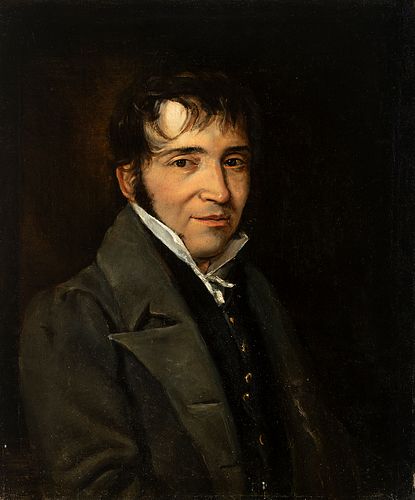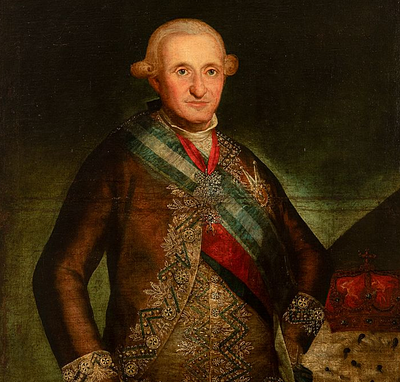Attributed to LUIS USEBI (Rome, 1773-Paris, 1829). "Portrait of a Gentleman. Oil on canvas. Relined
Lot 43
About Seller
Setdart Auction House
Carrer Aragó 346
Barcelona
Spain
Setdart Subastas was born in 2004 and is currently the first online art auction in Spain with solidity, prestige and reliability guaranteed by our more than 60,000 users. Setdart has a young, dynamic and enterprising team ready to successfully manage the purchase and sale of art works through custom...Read more
Estimate:
EUR€5,000 - EUR€7,000
$5,376.34 - $7,526.88
Absentee vs Live bid
Two ways to bid:
- Leave a max absentee bid and the platform will bid on your behalf up to your maximum bid during the live auction.
- Bid live during the auction and your bids will be submitted real-time to the auctioneer.
Bid Increments
| Price | Bid Increment |
|---|---|
| EUR€0 | EUR€10 |
| EUR€200 | EUR€25 |
| EUR€500 | EUR€50 |
| EUR€1,000 | EUR€100 |
| EUR€3,000 | EUR€200 |
| EUR€5,000 | EUR€500 |
| EUR€10,000 | EUR€1,000 |
| EUR€20,000 | EUR€2,000 |
| EUR€50,000 | EUR€5,000 |
About Auction
By Setdart Auction House
Sep 22, 2021
Set Reminder
2021-09-22 09:30:00
2021-09-22 09:30:00
America/New_York
Bidsquare
Bidsquare : 22nd September - ARAS JÁUREGUI Private Collection - Old Masters, 19th & 20th Century
https://www.bidsquare.com/auctions/setdart-auction-house/22nd-september---aras-j-uregui-private-collection---old-masters-19th-20th-century-7427
ARAS JÁUREGUI Private Collection - Old Masters, 19th & 20th Century Setdart Auction House sofia@setdart.com
ARAS JÁUREGUI Private Collection - Old Masters, 19th & 20th Century Setdart Auction House sofia@setdart.com
- Lot Description
Attributed to LUIS USEBI (Rome, 1773-Paris, 1829). "Portrait of a Gentleman. Oil on canvas. Relined Reproduced in the catalogue Measurements: 52,5 x 43,5 cm. Portrait of romantic aesthetics in which a half-bodied male figure is represented, inscribed in a neutral background of dark tonality. The sitter's gesture is sober and, to a certain extent, distant from the viewer, largely due to the chromatic range used by the artist. He is elegantly dressed in a black frock coat, a waistcoat of the same colour with gold buttons and a white shirt with a wide collar. Both the clothes and the haircut indicate that this is an early 18th-century figure, dressed in romantic fashion and related to English dandyism. During this period, men's fashion experienced great splendour, focusing men's attention on their aesthetics. For this reason, terms such as currutaco or petimetre arose, in relation to those barons who were concerned with fashion, in such a way that it became a way of life, which affected both clothing and behaviour and attitudes. This trend aroused a great deal of criticism and led to these characters being misunderstood, a trait that fitted in perfectly with the Romantic ideal. Returning to the portrait itself, it is worth noting that it has a linear and very precise drawing. The author was interested in the truthful reflection of the qualities, and also in a meticulously treated light study, which is based on a spotlight that falls directly on the sitter's face, giving it a great warmth that is even reflected in the background. Of Roman origin, Eusebi is an artist of whom little is known of his early period in Rome or of his academic training in that city. However, in 1795 he moved to Madrid, where he began to work as a miniaturist and fan decorator, receiving important commissions such as those from the Casa Ducal de Osuna and Godoy himself. When the War of Independence broke out, Eusebi moved to Seville, Cadiz and finally London. He returned to Spain in 1814 to begin working under the king's tutelage and was appointed painter to the court in 1816. Two years later he was appointed concierge to the Royal Museum by the queen consort. He was one of the first people to work on the project of founding the Prado Museum, and his work consisted of selecting the works that formed part of the royal collections, with the intention of creating the Prado's own collection. In addition, his work also consisted of producing the first catalogues.
- Shipping Info
-
In-house shipping available. Please inquire at admin@setdart.com.
-
- Buyer's Premium



 EUR
EUR CAD
CAD AUD
AUD GBP
GBP MXN
MXN HKD
HKD CNY
CNY MYR
MYR SEK
SEK SGD
SGD CHF
CHF THB
THB















